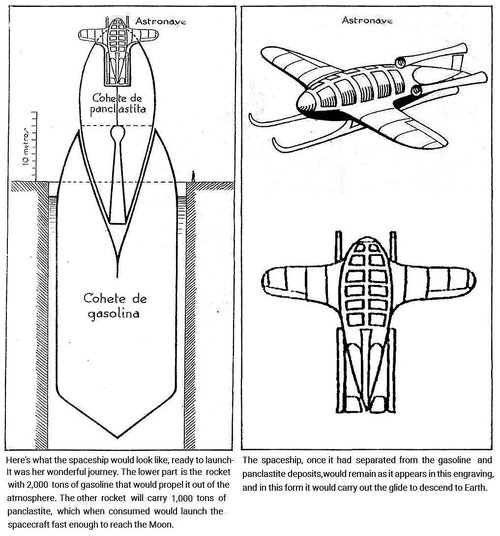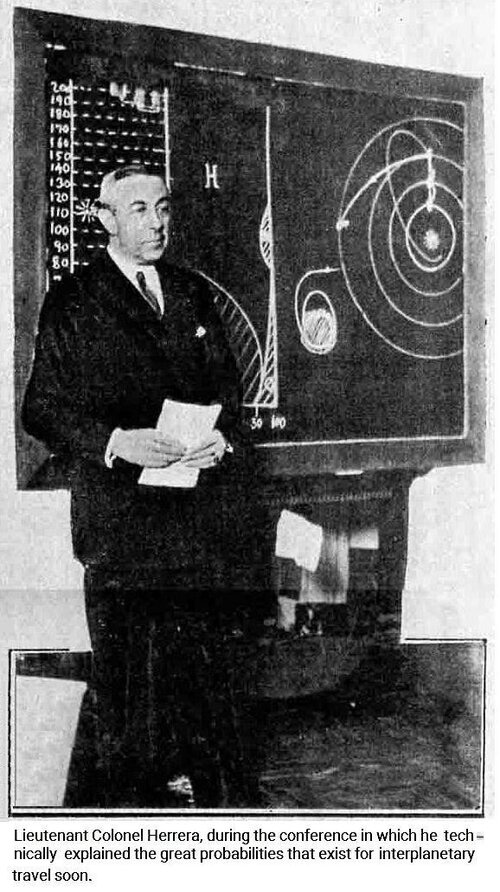klem
I really should change my personal text
- Joined
- 7 March 2015
- Messages
- 619
- Reaction score
- 1,252
Report in La Estampa Magazine n°224 of April 23, 1932. a prospective vision of space travel at a time when such a theme was tantamount to science fiction. The article published in (https://jaeinnova.wordpress.com/201...e-1932-interes-popular-por-la-astronautica-y- la-labor-de-emilio-herrera/) is a very interesting dissertation insofar as the author prefigures certain aspects of the message of the Voyager space probe. What emerges from the text itself on the first page below-" How trips to the Moon will be made before fifty years-Travelers will go to a spaceship that will travel through space at 33,000 kilometers per hour.
The trip to the Moon will not take long to complete.Lieutenant Colonel Don Emilio Herrera explains how it won't be long before what still seems like a fantasy becomes a reality. I am not referring precisely to descending on that planet, but to the trip around the Moon. The descent on a planet cannot be done by a spaceship with passengers. It could only be done to send newspapers. Do you think it is possible to send the Press, for example, to Mars?
That is currently possible. A rocket could be launched to Mars, Venus, Mercury, the Moon or the Sun. This would be done by means of a projectile with the same explosive charge, whatever its destination. The experience would be very expensive; therefore, it can only be thought of as propaganda for some journalistic company. In addition, since Mars is the planet where it seems most likely to be inhabited by intelligent beings, it could be chosen as the destination point for the rocket.
How would the newspaper be shipped so that it would not be spoiled by temperature differences? In the projectile a small package weighing one kilo would be sent, made of refractory clay, inside which a copy of the newspaper would be placed, printed on amint cloth, to prevent it from burning due to the heat developed by rubbing in the atmosphere of Mars and when hitting the ground. To warn the inhabitants of Mars of the origin of the shipment, a diagram of the planetary system indicating Earth and Mars and the path traveled by the rocket, a map of the Earth, a map of Mars, a collection of colored figures, representing human beings, animals and plants, landscapes, cities, houses, bridges, ships, trains, planes, airships and other signs of terrestrial progress; there are scientific ones, like the five regular polyhedrons; main curves, figure of the Pythagorean theorem, a scientific explanation of the decimal numbering system, etc.
How would the rocket? The rocket, which would carry the clay deposit at the tip, would have two parts: one containing two tons of gasoline, which would burn inside in atmösfern and break off at a height of three hundred kilometers, and another, with one ton of panclastite , which would continue to propel the rocket in its support, giving it a very fast rotation movement around its axis to avoid deviations when passing through the atmosphere. Was the projectile to be launched by day or by night?
It must be fired at dawn, to add the speed of the rocket to the translation of an Earth, and launch it two months before opposition from Mars. to reach its destination?" (google translate)
The trip to the Moon will not take long to complete.Lieutenant Colonel Don Emilio Herrera explains how it won't be long before what still seems like a fantasy becomes a reality. I am not referring precisely to descending on that planet, but to the trip around the Moon. The descent on a planet cannot be done by a spaceship with passengers. It could only be done to send newspapers. Do you think it is possible to send the Press, for example, to Mars?
That is currently possible. A rocket could be launched to Mars, Venus, Mercury, the Moon or the Sun. This would be done by means of a projectile with the same explosive charge, whatever its destination. The experience would be very expensive; therefore, it can only be thought of as propaganda for some journalistic company. In addition, since Mars is the planet where it seems most likely to be inhabited by intelligent beings, it could be chosen as the destination point for the rocket.
How would the newspaper be shipped so that it would not be spoiled by temperature differences? In the projectile a small package weighing one kilo would be sent, made of refractory clay, inside which a copy of the newspaper would be placed, printed on amint cloth, to prevent it from burning due to the heat developed by rubbing in the atmosphere of Mars and when hitting the ground. To warn the inhabitants of Mars of the origin of the shipment, a diagram of the planetary system indicating Earth and Mars and the path traveled by the rocket, a map of the Earth, a map of Mars, a collection of colored figures, representing human beings, animals and plants, landscapes, cities, houses, bridges, ships, trains, planes, airships and other signs of terrestrial progress; there are scientific ones, like the five regular polyhedrons; main curves, figure of the Pythagorean theorem, a scientific explanation of the decimal numbering system, etc.
How would the rocket? The rocket, which would carry the clay deposit at the tip, would have two parts: one containing two tons of gasoline, which would burn inside in atmösfern and break off at a height of three hundred kilometers, and another, with one ton of panclastite , which would continue to propel the rocket in its support, giving it a very fast rotation movement around its axis to avoid deviations when passing through the atmosphere. Was the projectile to be launched by day or by night?
It must be fired at dawn, to add the speed of the rocket to the translation of an Earth, and launch it two months before opposition from Mars. to reach its destination?" (google translate)


